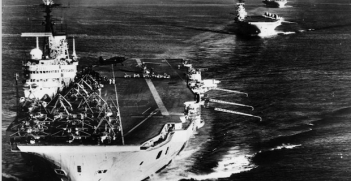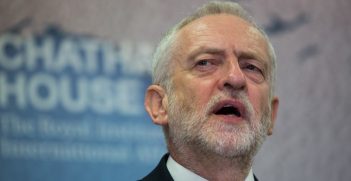Navigating the New International Disorder

This week marks the release of Navigating the New International Disorder, the 12th book in the Australia in World Affairs series. The AIIA has been publishing this authoritative account of Australian foreign policy every five years since 1950. However, recent upheavals and global issues mean that the 2011-2015 version is very different to its predecessors.
Australia’s foreign policy elites could be forgiven for thinking that they live in especially challenging times. The current international order appears to throw up a number of problems that not only defy easy resolution but also threaten to overturn many of the ideas and principles that have underpinned policymaking in Australia for many decades.
Perhaps the most obvious transformation worrying Australian foreign policymakers is the apparent weakening of the US-centred security order in East Asia and the re-emergence of China as a major power in the region. In the period 2011–15 we have seen the first expressions of a growing Chinese willingness to challenge the status quo, most notably in the East and South China Seas, unsettling Japan, several Southeast Asian states and others in the process.
Challenges to the Western-dominated international order have also emerged in Europe, where Russia unilaterally annexed Crimea, taking it from the Ukraine in March 2014, despite strong protests from the European Union and the United States. Although Australia has cleaved ever closer to its long-standing ally, some commentators have argued that the dissonance between the US alliance and Australia’s close economic relationship with China will grow, potentially forcing tougher choices in the future.
Also disconcerting to policymakers has been the emergence or intensification of a range of transnational, ‘non-traditional’ security problems, including terrorist groups such as Islamic State, climate change, environmental degradation, pandemics and even, for some, irregular migration. These problems are rarely the result of intentional aggression from another state, but are either the undesirable externalities of economic development or are associated with the activities of non-state groups.
They are usually not seen to threaten the state’s very survival, but do undermine its real or perceived capacity to protect national populations. Traditional security responses, such as deterrence or alliance-formation, are usually seen as no longer appropriate for these issues, and nor are responses focusing strictly on intergovernmental diplomatic relations. As a result, Australian foreign policy-making has expanded beyond the traditional ‘three Ds’— diplomacy, defence and development assistance—to include a range of new departments which previously had a more restricted domestic role. The most significant example from the last five years is the fast-evolving and internationalising Department of Immigration and Border Protection.
Meanwhile, traditional foreign policy actors in Australia, such as the Department of Foreign Affairs and Trade, have had to acquire new ways of implementing and developing policy, as well as establishing new relationships with other agencies inside and outside the Australian bureaucracy, producing new challenges of coordination.
Traditionally, foreign policy-making in Australia was seen as an elite pursuit, dominated by a handful of policymakers and bureaucrats with limited scrutiny, even by Parliament. Yet, increasingly the public discourse surrounding foreign policy issues has taken on populist tones, as the issues, and the way they are managed, are seen as having implications for Australians’ everyday lives. This reflects the blurring of the distinction between domestic and foreign policies wrought by the growing complexity associated with public policy-making in an interconnected, globalised world. It is, in other words, another manifestation of the same processes that have made foreign policy-making appear more challenging in general.
Specifically, the tighter interplay between the domestic and foreign policy arenas has broadened the range of interests and groups with a stake in the way many foreign policy issues are managed. This has two important and interrelated implications: first, it is clear that attaining coherent, ‘national’ positions on most issues of consequence is becoming more difficult in practice than in the past. Second, from a normative perspective, governments’ claims to be acting in the ‘national interest’ internationally are becoming even more problematic.
Foreign policy has been part of the construction of particular national identities and social relations within Australia since before Federation. Yet the relationship between foreign policy and identity-construction at home is becoming more contentious, as it is increasingly apparent that acting in the national interest actually advances only some interests within Australian society.
Mindful of these developments, we have decided to break with tradition and make this the first edition of Australia in World Affairs since the series began in 1950 to be organised around key themes and issues in Australia’s international relations and foreign policy, rather than around Australia’s bilateral relations. The most important issues today encompass a set of processes and relations that cannot be simply or adequately captured through an emphasis on the relations between two or more governments.
A less predictable world order
Australia now seems to be facing a more uncertain international environment than it has done for decades. Serious transnational threats that are beyond the capacity of Australian policymakers to alleviate single-handedly seem to be multiplying, while the rise of China appears to challenge the long-standing US-led security order in Asia. Both potentially undermine traditional approaches to foreign policymaking in Australia.
As non-capitalist alternatives were weakened and the threat of large-scale war between the superpowers receded, many states, especially the United States, were able to refocus their foreign policies towards opening up markets for ‘their’ corporations in other countries. Thus, during the 1990s there was a noteworthy, though partial, shift in the priorities of policymakers around the world, from geopolitics to geoeconomics.
Geoeconomics is distinguished from geopolitics in that the latter emphasises power in the context of a territorially demarcated state system, whereas the former emphasises power underpinned by control over trans-border flows and markets.
The shift to geoeconomics has also entailed a change in the way security is understood, from a near-exclusive focus on the threat posed by powerful states towards a more comprehensive view of security that includes a range of border-spanning, often non-state, security problems, such as environmental degradation, climate change, organised crime, terrorism, infectious disease and even irregular migration.
In short, what we have seen is a partial change both in policymakers’ perceptions of the international economic and security environments and in the ways in which they seek to deal with these issues. This process of globalisation continues today, despite the apparent decoupling of emerging economies from the traditional centres in the North Atlantic since the onset of global financial crisis.
First, the perception of transnational vulnerability to new security problems is now firmly established and not subject to the ebb and flow of interstate economic relations. Second, the winding down of the US Federal Reserve’s program of quantitative easing appears to have affected investment in emerging economies, leading to significant economic downturn, especially in Brazil, which has seen its gross domestic product go into negative territory.
In China, meanwhile, current economic wobbles and a long-term crisis of over-capacity suggest that the government stimulus program could not forever defy the downward pressures on economic growth wrought by declining demand in the West.
Traditionally, international relations scholars and policymakers have understood both structure and agency in world politics as constituted by inter-state relations. Now, however, internal and external transformations associated with globalisation have eroded the neat separation of the world into territorialised ‘power containers’, which the Cold War had reinforced.
As a result, even for the most powerful states, the outputs of foreign policy decisions have become more complex and unpredictable.
This is an edited extract from the introduction to Australia in World Affairs 2011-2015: Navigating the New International Disorder, edited by Mark Beeson and Shahar Hameiri and published by OUP. It has been republished with permission.
Mark Beeson is professor of political science and international relations at the University of Western Australia.
Shahar Hameiri is associate professor and associate director of the Graduate Centre in Governance and International Affairs in the School of Political Science and International Studies at the University Queensland.
Navigating the New International Disorder is available from the Australian Institute of International Affairs at a significant discount and can be ordered here.





